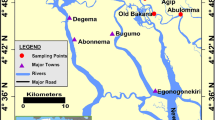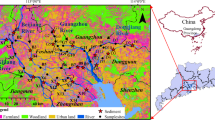Abstract
The objectives of this study are to track the occurrence, distribution, and sources of phenolic endocrine disrupting compounds (EDCs) in the 22 rivers around Dianchi Lake in China, to estimate the input and output amounts of phenolic EDCs in the water system, and to provide more comprehensive fundamental data for risk assessment and contamination control of phenolic EDCs in aquatic environment. Six phenolic EDCs were systematically evaluated in water and surface sediment in the estuaries of those rivers. The water and sediment samples were preconcentrated by solid-phase extraction system and microwave-assisted extraction system, respectively. Phenolic EDCs were analyzed by GC-MS (Thermo Fisher Scientific, USA) after derivatization. Phenolic EDCs were found ubiquitously in the aquatic environment. The total concentrations ranged from 248 to 4,650 ng/L in water, and 113 to 3,576 ng/g dry weight in surface sediment. The residue amount of phenolic EDCs in Dianchi Lake was 258 kg/a. Concentrations of the phenolic EDCs in the Lake decreased with increase in distance to the estuaries of those rivers which run through urban and industrial areas. The rivers seriously contaminated by phenolic EDCs were Xin River, Yunliang River, Chuanfang River, Cailian River, Jinjia River, Zhengda River, and Daqing River which run through the old area of Kunming City. Satisfying correlations were observed between the concentrations of the target compounds in water and in surface sediment. NP1EO, NP2EO, and BPA were identified as the three predominant phenolic EDCs. There were significant correlations between phenolic EDCs and many basic water quality parameters. Urban and industrial areas are the major contributors for phenolic EDCs, especially in Kunming City. Compositional profiles of phenolic EDCs in surface sediment were similar to those in river water. The concentrations of phenolic EDCs in the rivers located in the northwest part of the valley were very high, and posed a potential risk to aquatic organisms and even human. The concentrations of NP2EO, NP1EO, and BPA were at moderate levels of other areas. The basic water quality parameters (TOC, TN, DO, and pH) play important roles on the distribution, fate, and behavior of phenolic EDCs in the valley.





Similar content being viewed by others
References
Cailleaud K, Forget-Leray J, Souissi S, Lardy S, Augagneur S, Budzinski H (2007) Seasonal variation of hydrophobic organic contaminant concentrations in the water-column of the Seine Estuary and their transfer to a planktonic species Eurytemora affinis (Calanoïd, copepod). Part 2: alkylphenol–polyethoxylates. Chemosphere 70:281–287
Duong CN, Schlenk D, Chang NI, Kim SD (2009) The effect of particle size on the bioavailability of estrogenic chemicals from sediments. Chemosphere 76:395–401
Funakoshi G, Kasuya S (2009) Influence of an estuary dam on the dynamics of bisphenol A and alkylphenols. Chemosphere 75:491–497
Giger W, Brunner PH, Schaffner C (1984) 4-Nonylphenol in sewage sludge: accumulation of toxic metabolites from nonionic surfactants. Science 225:623–625
Hibberd A, Maskaoui K, Zhang Z, Zhou JL (2009) An improved method for the simultaneous analysis of phenolic and steroidal estrogens in water and sediment. Talanta 77:1315–1321
Hohne C, Puttmann W (2008) Occurrence and temporal variations of the xenoestrogens bisphenol A, 4-tert-octylphenol, and tech. 4-nonylphenol in two German wastewater treatment plants. Environ Sci Pollut Res 15:405–416
Jeannot R, Sabik H, Sauvard E, Dagnac T, Dohrendorf K (2002) Determination of endocrine-disrupting compounds in environmental samples using gas and liquid chromatography with mass spectrometry. J Chromatogr A 974:143–159
Jin XL, Jiang GB, Huang GL, Liu JF, Zhou QF (2004) Determination of 4-tert-octylphenol, 4-nonylphenol and bisphenol A in surface waters from the Haihe River in Tianjin by gas chromatography–mass spectrometry with selected ion monitoring. Chemosphere 56:1113–1119
Jonkers N, Kohler HPE, Dammshäuser A, Giger W (2009) Mass flows of endocrine disruptors in the Glatt River during varying weather conditions. Environ Pollut 157:714–723
Kammann U, Vobach M, Wosniok W, Schaffer A, Telscher A (2009) Acute toxicity of 353-nonylphenol and its metabolites for zebrafish embryos. Environ Sci Pollut Res 16:227–231
Liu Y, Guan YT, Tam NFY, Mizuno T, Tsuno H, Zhu WP (2010) Influence of rainfall and basic water quality parameters on the distribution of endocrine-disrupting chemicals in coastal area. Water Air Soil Pollut 209:333–343
Lu J, Jin Q, He Y, Wu J, Zhao J (2008) Biodegradation of nonylphenol ethoxylates by Bacillus sp LY capable of heterotrophic nitrification. FEMS Microbiol Lett 280:28–33
Matsushima A, Teramoto T, Okada H, Liu XH, Tokunaga T, Kakuta Y, Shimohigashi Y (2008) ERRγ tethers strongly bisphenol A and 4-α-cumylphenol in an induced-fit manner. Biochem Biophys Res Commun 373:408–413
Navarro A, Endo S, Gocht T, Barth JAC, Lacorte S, Barceló D, Grathwohl P (2009) Sorption of alkylphenols on Ebro River sediments: comparing isotherms with field observations in river water and sediments. Environ Pollut 157:698–703
Patrolecco L, Capri S, De Angelis S, Pagnotta R, Polesello S, Valsecchi S (2006) Partition of nonylphenol and related compounds among different aquatic compartments in Tiber River (Central Italy). Water Air Soil Pollut 172:1–4
Quednow K, Püttmann W (2008) Endocrine disruptors in freshwater streams of Hesse, Germany: changes in concentration levels in the time span from 2003 to 2005. Environ Pollut 152:476–483
Soares A, Guieysse B, Jefferson B, Cartmell E, Lester JN (2008) Nonylphenol in the environment: a critical review on occurrence, fate, toxicity and treatment in wastewaters. Environ Int 34:1033–1049
Terasaki M, Shiraishi F, Nishikawa T, Edmonds JS, Morita M, Makino M (2005) Estrogenic activity of impurities in industrial grade bisphenol A. Environ Sci Technol 39:3703–3707
Wang B, Wan X, Zhao SM, Wang Y, Yu F, Pan XJ (2011a) Analysis of six phenolic endocrine disrupting chemicals in surface water and sediment. Chromatographia 74:297–306
Wang L, Ying GG, Zhao JL, Liu S, Yang B, Zhou LJ, Tao R, Su HC (2011b) Assessing estrogenic activity in surface water and sediment of the Liao River system in northeast China using combined chemical and biological tools. Environ Pollut 159:148–156
Wang B, Huang B, Jin W, Wang Y, Zhao SM, Li FR, Hu P, Pan XJ (2012) Seasonal distribution, source investigation and vertical profile of phenolic endocrine disrupting compounds in Dianchi Lake, China. J Environ Monit 14:1275–1282
Xu J, Wang P, Guo WF, Dong JX, Wang L, Dai SG (2006) Seasonal and spatial distribution of nonylphenol in Lanzhou Reach of Yellow River in China. Chemosphere 65:1445–1451
Ying GG, Williams B, Kookana R (2002) Environmental fate of alkylphenols and alkylphenol ethoxylates—a review. Environ Int 28:215–226
Zhang YZ, Song XF, Kondoh A, Xia J, Tang CY (2011) Behavior, mass inventories and modeling evaluation of xenobiotic endocrine-disrupting chemicals along an urban receiving wastewater river in Henan Province, China. Water Res 45:292–302
Zhao JL, Ying GG, Wang L, Yang JF, Yang XB, Yang LH, Li X (2009) Determination of phenolic endocrine disrupting chemicals and acidic pharmaceuticals in surface water of the Pearl Rivers in South China by gas chromatography–negative chemical ionization–mass spectrometry. Sci Total Environ 407:962–974
Zuo YG, Zhang K, Lin YJ (2007) Microwave-accelerated derivatization for the simultaneous gas chromatographic–mass spectrometric analysis of natural and synthetic estrogenic steroids. J Chromatogr A 1148:211–218
Zuo YG, Zhang K, Wu JP, Men B, He MC (2011) Determination of o-phthalic acid in snow and its photochemical degradation by capillary gas chromatography coupled with flame ionization and mass spectrometric detection. Chemosphere 83:1014–1019
Acknowledgments
This work was supported by the National Natural Science Foundation of China (grant no. 20767002), Environmental Protection Commonweal Scientific Research Foundation of China (grant no. 200809136), Yunnan Provincial Natural Science Foundation (grant no. 2007B035M), and State Key Laboratory of Environmental Chemistry and Ecotoxicology, Research Center for Eco-Environmental Sciences, Chinese Academy of Sciences (grant no. KF2008-09).
Author information
Authors and Affiliations
Corresponding author
Additional information
Responsible editor: Leif Kronberg
Rights and permissions
About this article
Cite this article
Wang, B., Huang, B., Jin, W. et al. Occurrence, distribution, and sources of six phenolic endocrine disrupting chemicals in the 22 river estuaries around Dianchi Lake in China. Environ Sci Pollut Res 20, 3185–3194 (2013). https://doi.org/10.1007/s11356-012-1236-y
Received:
Accepted:
Published:
Issue Date:
DOI: https://doi.org/10.1007/s11356-012-1236-y




